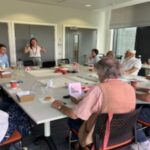Written by Lindsay Welch (@LindsayICOPD) on behalf of the Pulmonary Rehabilitation Education Consortium (PREC) group
Welch, L1,2. Williams, S4. Sgroi, E1. Barker, R.E3. Pritchard, A5. Graham, L6. Loughran, K7. Armstrong, M8. Clifton, H9. Roberts, NJ10
 1 Faculty of Health and Social Sciences, Bournemouth University, 2 University Hospital Dorset NHS Foundation Trust, 3 Health Innovation Wessex, 4 International Primary Care Respiratory Group, 5 Hampshire and Isle of Wight Healthcare NHS Foundation Trust, 6 Homerton NHS Foundation Trust, 7 Teesside University, 8 Durham University, 9 City St George’s, University of London, 10 School of Health and Social Care, Edinburgh Napier University.
1 Faculty of Health and Social Sciences, Bournemouth University, 2 University Hospital Dorset NHS Foundation Trust, 3 Health Innovation Wessex, 4 International Primary Care Respiratory Group, 5 Hampshire and Isle of Wight Healthcare NHS Foundation Trust, 6 Homerton NHS Foundation Trust, 7 Teesside University, 8 Durham University, 9 City St George’s, University of London, 10 School of Health and Social Care, Edinburgh Napier University.
Public and Patient Involvement and Engagement
Patient and public involvement and engagement, PPIE, is a no longer a new concept in research, but how we meaningfully involve and ensure fair public contribution requires consideration to ensure it is embedded throughout our research practice. Patients’ feedback, advice and guidance quite rightly needs to be woven through every stage of the research process and inform the work we do, whether it is research focussed, or direct healthcare service improvement, as the outcomes are seeking to impact patient care and service delivery. It is also important to develop, grow and value the partnerships made with patients, patients’ carers, members of the public, clinicians and researchers.
Guidance from NIHR INVOLVE defines this process as ‘’research being carried out ‘with’ or ‘by’ members of the public rather than ‘to’, ‘about’ or ‘for’ them’’ (INVOLVE Guidance HRA 2025).
As nurses and allied health professionals we often consider ourselves to be more likely to have insights into patient perspectives, with our roles and research often acting as a conduit for the patient voice, reflected through our research outputs. However, it is only when you work closely with these expert patients and members of the public that you understand the real value of involving patients more closely in research. They are passionate and driven members of the public who advocate for their peers and can discuss and be open about deeply personal aspects of their lives and their health.
Meaningful involvement: Co-Production
Co-production is somewhat of an umbrella term for elements of collaboration in the design, delivery and dissemination of research. It places an emphasis on the ‘co’ element, with the implication that collaboration is embedded in each part of the research design process. Inclusion of patients and the public in the research process allows us to garner opinions, perspectives, and direction, to the individual’s needs.
This could be through online platforms opinion polls, interactive, live feedback tools such as mentimeter, gamification for adolescents, open meeting forums, focus groups, or a target co-design workshop to elicit a clear answer or steer for a specific question or challenge. Further approaches can be even more creative, such arts-based engagement, use of sand trays, or comic-based illustrations (Harrison, S.L. et al 2023). These creative approaches can be used to explore deeper problems, consider alternative perspectives, and develop user led prototypes (Grindell, C. et al 2022).
We can harness co-production with patients, service users and people with lived experiences to have prominent roles in shaping and deciding what questions we NEED to ask, what they value in their care, and what people who use our service would like investigated. Involving different stakeholders, promoting discussion, cooperating, and integrating resources aligns to the complex system of the health service and the multiple agents within it (Marsilio, M. 2021). Involving multiple people together in this way within co-production supports forming the actual research question and setting out the priorities for investigation.
Working with others – our experiences
The PREC group are primarily focused with the development of inclusive and accessible learning materials for people with lung disease who attend pulmonary rehabilitation. The first, and most critical part of this development was to gather a group of people who have lived experience of a lung condition and have had the need for education for their condition on how to manage their disease and live well.
Therefore, we selected a region of the UK with a higher population of people who have lung disease, which was the Northeast of England. We invited people from local community and rehabilitation groups to a workshop. The workshop was an initial co-design event, planned in the first instance to garner the views and perspectives around teaching and learning in respiratory care.
We asked these key questions:
What do you need to know to help you with your respiratory illness?
How should teaching and listening work?
How was it told to you, and how did you like the information delivered?
How do you like to be given information about your health?
The group met, informally over lunch. The workshop questions were posed and the large public group split into groups with a PREC member (researcher) as a note taker and facilitator only. The group discussed the questions and were able to openly debate the issues of learning about clinical conditions from clinicians. Written UK resources from the public domain were reviewed, and the preferences and content described by the participants. The public participants valued a mix of self-directed learning supported by healthcare professionals, promoting autotomy whilst ensuring reliability.
This event yielded rich narratives, that will now directly inform the next stage of development, the context, and the delivery of the educational materials. This co-production exercise has been analysed and submitted to two conferences (International Primary Care Respiratory Group Conference and European Respiratory Society Conference).
 Figure 1: Workshop group lunch and briefing session.
Figure 1: Workshop group lunch and briefing session.
Learning from feedback – changing our practice
Through these examples of delivering co-production workshops with public and clinical contributors, our lens has shifted to understand and embed the contributions of all parties into the design of projects. Not just to gain feedback, but to sense check whether your interpretation of their words align to their expectations in the project.
Moreover, clinicians need to allow the patient and public to lead, advise and then act on these contributions to develop meaningful co-produced projects. The workshop participants will continue to be involved in the whole research development cycle, developing the methods, delivering the research, and being part of steering the project to ensure we do not deviate from the original goals and intentions.
 Figure 2: Education documents to be reviewed by the PPIE group
Figure 2: Education documents to be reviewed by the PPIE group
Summary
By working collaboratively, as equals with the public, and listening, we have learnt to expect more, ask for more, and acknowledge equity in their contributions. Experts are the people who live every day with a condition and we as clinicians and researchers come only with an outsider perspective.
In our carefully developed objectives and methods we need to be prepared to listen, change direction, learn to adapt and modify, seek early involvement from community and public contributors, and really listen.
References
Harrison, S.L., Lawrence, J., Suri, S. et al. Online comic-based art workshops as an innovative patient and public involvement and engagement approach for people with chronic breathlessness. Res Involv Engagem 9, 19 (2023). https://doi.org/10.1186/s40900-023-00423-8
Health Research Authority (HRA), 2025. Planning and improving research. Web guidance. https://www.hra.nhs.uk/planning-and-improving-research/best-practice/public-involvement/#:~:text=Public%20involvement%20in%20research%20means,is%20designed%2C%20conducted%20and%20disseminated Accessed Feb 2025.
Grindell, C., Coates, E., Croot, L. et al. The use of co-production, co-design and co-creation to mobilise knowledge in the management of health conditions: a systematic review. BMC Health Serv Res 22, 877 (2022). https://doi.org/10.1186/s12913-022-08079-y
Marsilio, M., Fusco, F., Gheduzzi, E., & Guglielmetti, C. (2021). Co-Production Performance Evaluation in Healthcare. A Systematic Review of Methods, Tools and Metrics. International Journal of Environmental Research and Public Health, 18(7), 3336. https://doi.org/10.3390/ijerph18073336
Dr Lindsay Welch: @LindsayICOPD